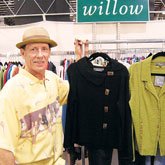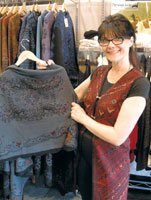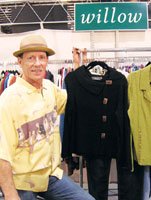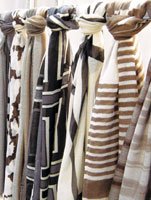Fashion Market Northern California Attracts Buyers Only Days After Las Vegas Shows
SAN MATEO, Calif.—Heidi Howard, notebook in tow, was on a mission.Wandering up and down the wide aisles of Fashion Market Northern California, she was hunting for only “Made in USA” merchandise for her recently opened store in the quaint downtown of San Carlos, Calif.
“I usually don’t shop this show, but I am here to look for American-made goods,” said the owner of Earthy Treasures, located in Foster City, Calif., for 36 years until a new shopping-center owner prompted Howard to move her boutique.With the move to a new city, Howard decided her business model would take on a new approach, too: all American-made goods. “I find that American quality is better. You pay for what you get,” Howard said in her no-nonsense way of speaking. “Women are really, really interested in buying products made in the USA.”
Her merchandise, which ranges from casualwear to workplace clothing with an accent on natural fibers, retails from $5 for earrings up to $200 for jackets. She finds she doesn’t have to break the bank to stock American-made clothing. Her T-shirts sell for $40, and a simple shirt carries a $35 price tag.Howard was one of an eclectic mix of Northern California store buyers who made it to the Holiday/Resort season of Fashion Market Northern California, held Aug. 26–28 in the San Mateo County Event Center. They all had a mission, whether it was fill-in goods for quick delivery or to take a peek at Spring merchandise.
Because the show takes place days after all the big apparel shows in Las Vegas, this particular edition of Fashion Market California is one of the slowest of the five markets organized by the Golden Gate Apparel Association. In 2009, the August show was canceled when the recession was just revving up and not enough exhibitors signed up.
But these are different times. Suzanne De Groot, the show’s executive director, said there were 124 exhibitors this August, compared with 107 exhibitors last year.
“I’m feeling good about the show, but it feels slower than other shows,” she said. “Everybody who is coming here is buying.”
Fill-in orders and Spring Marie-Christine Girton found out firsthand that buyers were shopping at the show. As director of sales for Peruvian Link, a line of alpaca-centric apparel made in Peru, this was her first time exhibiting at a California trade show. The company, based in Amherst, Maine, has a heavy customer base in Canada and the northeastern United States, where the winters are longer and colder.But she decided to test the waters at Fashion Market Northern California, where many of the store owners are from the upper reaches of California, with its more seasonal climate, and Washington and Oregon.
Her first time at the show was very positive. After the second day, she already had 10 orders from customers in Northern California, and several people had taken notes, which is often a precursor to buying merchandise. “The first day was pretty busy,” Girton said. “I would like to come and test the show again in January and April, which is our busy season.”
The company’s merchandise is mostly 50 percent alpaca and 50 percent acrylic, which helps keep wholesale costs down to around $100 and under. Long, colorful sweater vests wholesale for $74.
But other new exhibitors weren’t as fortunate in their first-time experience. Pamela Carone, whose Pamela Carone Studio is located in the Los Angeles suburb of Brentwood, sells 100 percent hand-woven cashmere scarves made in Nepal under the Kate Kanyon label and contemporary clothing made in Argentina under the Viviana Uchitel label.Carone felt she had picked the wrong date to test market Fashion Market Northern California. In the past, she has shown at CALA, the five-times-a-year show held at the Westin St. Francis hotel in San Francisco and organized by the Contemporary Association of Los Angeles.
Still, she did have a buyer from the Fairmont hotel drop by Fashion Market Northern California who was interested in the cashmere scarves, which come in artistic prints and 75 colors and wholesale for $115 to $145.“I will try it one more time, in October,” she said. “But it would be great if CALA and this market were under one roof. It would be better for everybody.”
Loyal customers Tried-and-true exhibitors at the show said this is the market where you meet your regular customers who are eager to fill in orders or see early Spring lines.Don Reichman, whose is on the executive board of Fashion Market Northern California and whose Don Reichman Associates showroom is located in the California Market Center in Los Angeles, said this is where he meets his key clients. “I come up here to make sure they see the latest things,” he said, surrounded by the five lines he represents: Barbara Lesser, Ava Knits, Karissa & Me, Tricotto and Jane & John. The last two lines are based in Montreal and have an earlier order schedule like European lines.He said almost half his orders were for 10/30 and 11/30 delivery dates.Michael Farrell, another regular exhibitor who brings five upper-moderate lines to the show—including Sylvie & Madó, Whitewash and Willow—was trying to be upbeat. “Traffic is off, but we’re here to do business,” he said, noting the first day, which was a Sunday, was brisk with boutiques.
A good portion of the buyers wandering through the show had attended one or more trade shows in Las Vegas, but they were at San Mateo to fill in orders.Raine Daufeldt, the buying manager for Rabat, which has two stores in San Francisco and a shoes and accessories store in Berkeley, Calif., was there to place orders for European lines, whose buying season is earlier than for American and Asian labels.
“I’m shopping the lines that only have a couple of collections a year so I can get delivery,” she said, noting she had gone to Project and FN Platform the previous week in Las Vegas.
She said customers are still cautious, “but they are letting go of their purse strings a little more.” ●


























